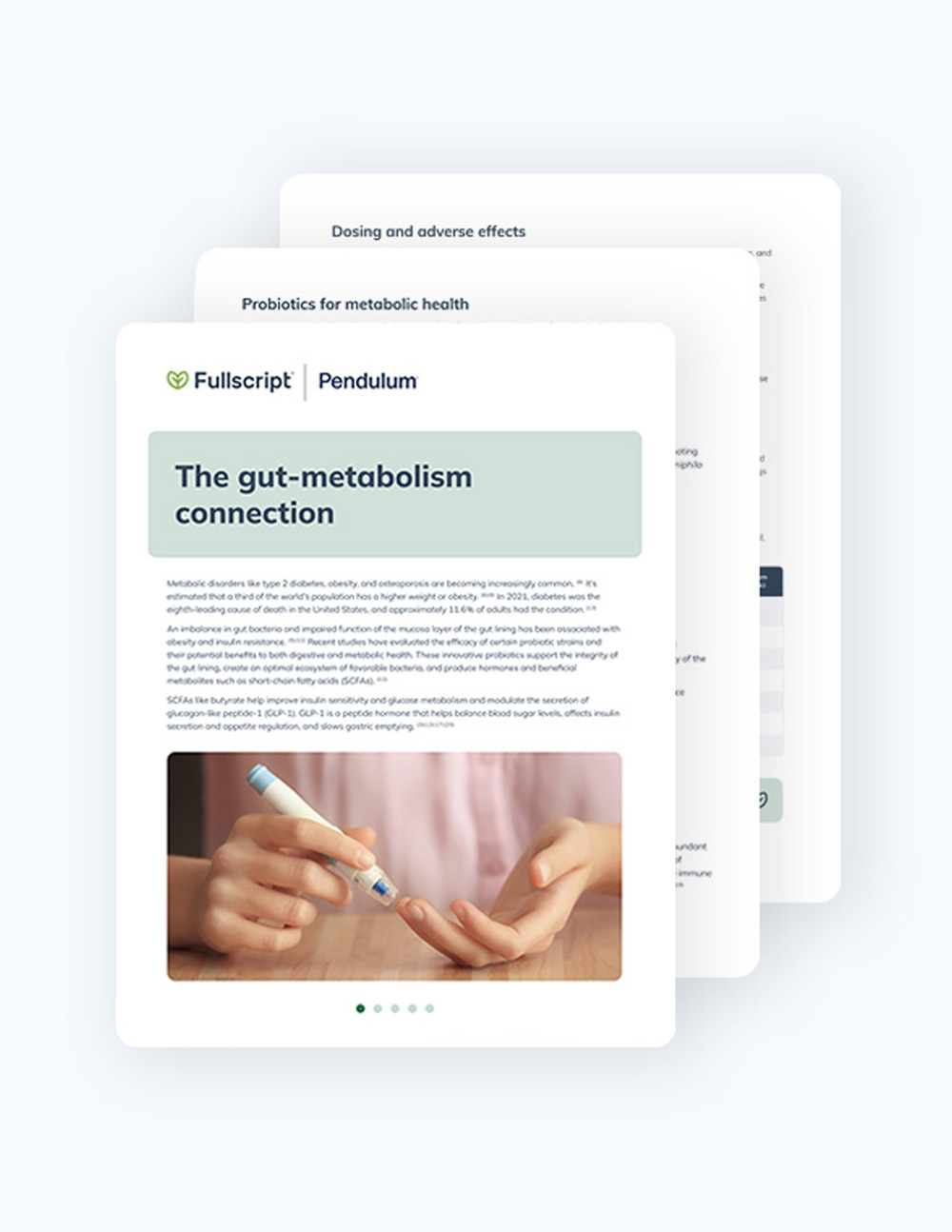What do food sensitivities, rheumatoid arthritis, and anxiety all have in common? These various conditions have all been associated with poor gut health. (5)(13) From poor diet to excess stress, many factors can negatively impact digestive function, potentially resulting in increased intestinal permeability, systemic inflammation, (11) and the development of certain health conditions. (20) The 4R protocol may be utilized to restore optimal gut health, which involves the four steps of remove, replace, reinoculate, and repair.
Learn more about increased intestinal permeability and how you can heal your gut naturally with the 4Rs for gut healing protocol below.
What Is Intestinal Permeability?
The intestinal tract is the body’s primary physical barrier from the outside world, protecting us from potentially harmful environmental factors passing through the digestive tract, including toxins, pathogenic microorganisms, and other antigens. (12)
The intestinal lining consists of a single layer of epithelial cells separated by protein complexes known as tight junctions (TJs). In a healthy gut, TJs regulate intestinal permeability, selectively allowing the transport of substances such as water, electrolytes, and nutrients from the gut lumen (the space inside the intestines) across the intestinal barrier, while preventing the absorption of harmful substances. (17)
Ready to start delivering better patient care?

However, certain environmental factors can damage TJs, resulting in increased intestinal permeability, also referred to as intestinal hyperpermeability or leaky gut syndrome. (17) Contributors to increased intestinal permeability include dietary excesses (e.g., saturated fat, alcohol), nutrient deficiencies (e.g., vitamin D, fiber), stress, and infections (e.g., Helicobacter pylori bacterial infection). (12)
Increased intestinal permeability may enable antigens to cross the gut mucosa into systemic circulation, resulting in an immune response and low-grade inflammation. (11) Intestinal hyperpermeability has been associated with certain gastrointestinal conditions, such as irritable bowel syndrome, (7) ulcerative colitis, and Crohn’s disease, (2) as well as certain autoimmune conditions, such as celiac disease, (14) type 1 diabetes (2) and rheumatoid arthritis. (13)

How to Heal Your Gut Naturally with the 4Rs
The 4Rs involve a four-step protocol used to address digestive conditions and support gut healing. Read on to understand how you can improve your gut health in four steps.
1. Remove Inflammatory Triggers and Pathogens
The first step is to remove pathogens and other inflammatory triggers, such as stress and chronic alcohol consumption, associated with increased intestinal permeability. Targeting pathogens may involve treatment with pharmaceutical medication, antibiotics, or antimicrobial herbal supplements. (18) Inflammatory foods should also be removed from the diet, including:
- Alcohol
- Food additives (e.g., salt, emulsifiers, solvents)
- Food sensitivities, which may be identified through the elimination diet
- Gluten, a protein found in certain grains (e.g., wheat, barley, rye)
- Refined starches and sugar
- Saturated and trans-fatty acids (8)(9)

2. Replace Inflammatory Foods with Gut Healing Foods
The second step is to replace inflammatory foods with dietary nutrients and gut-healing foods that help to reduce inflammation and support digestive health. Anti-inflammatory foods include:
- Anti-inflammatory herbs and spices (e.g., turmeric, rosemary, garlic)
- Extra virgin olive oil
- High-fiber foods (e.g., vegetables, fruit, nuts)
- Mushrooms
- Omega-3 fatty acids, found in wild-caught fish (3)(8)
Certain dietary supplements may also be used to support digestive function, assisting in the digestion and absorption of dietary nutrients. Digestive enzymes assist in the breakdown of fats, proteins, and carbohydrates and may benefit individuals with impaired digestive function, food intolerances (e.g., lactose intolerance), or celiac disease. Bile acid supplements can also assist in nutrient absorption by emulsifying lipids. Bile acids have been used to treat conditions of the liver, gallbladder and bile duct, and have been shown to prevent gallstone formation following bariatric surgery. (10)
Read more about the anti-inflammatory diet on the Fullscript blog.

3. Reinoculate Your Microbiota with Beneficial Bacteria
The third step is to reinoculate the microbiota with beneficial bacteria. Probiotic supplementation has been shown to improve the composition of microbiota by restoring beneficial gut bacteria species such as Bifidobacterium and Lactobacillus. (18)
Probiotic supplements may improve the health of your digestive system by enhancing secretion of anti-inflammatory substances, supporting immune system function, (6) altering microbial composition, and reducing intestinal permeability. (12)
Probiotics are also found in fermented foods, such as yogurt, fermented vegetables, fermented soy products, and kombucha, a fermented tea. Probiotics in food are considered transient as they do not persist in the human gastrointestinal tract. Interestingly, they may still impact human health by producing vitamins and anti-microbial compounds, as well as influencing gut microbiota diversity and function. (16)

4. Repair the Gut Lining
The final step involves repairing the gut lining with specific nutrients and medicinal herbs that have been shown to decrease intestinal permeability and inflammation. Examples of these ingredients include:
- Aloe vera
- Chios mastic gum (Pistacia lentiscus-Anacardiaceae)
- Deglycyrrhizinated licorice (DGL)
- L-glutamine
- Marshmallow root (Althaea officinalis)
- Omega-3 fatty acids
- Polyphenols, which are compounds found in plants (e.g., quercetin, myricetin, curcumin)
- Vitamin D
- Zinc (1)(4)(9)(15)(19)
The Bottom Line: Follow the 4Rs to Improve Your Gut Health
Many dietary and lifestyle factors can adversely affect digestive health and contribute to a number of health conditions. The goal of the 4Rs is to minimize factors that may lead to increased intestinal permeability and inflammation, as well as introduce factors to help heal your digestive system and improve gut health.
If you’re a patient and you think you could benefit from the 4R protocol, speak with your integrative healthcare practitioner for guidance and to determine if introducing dietary supplements to your wellness plan is appropriate for you.
- Al-Snafi, A. E. (2013). The pharmaceutical importance of Althaea officinalis and Althaea rosea: A review. International Journal of PharmTech Research, 5(3), 1378-1385.
- Arrieta, M. C., Bistritz, L., & Meddings, J. B. (2006). Alterations in intestinal permeability. Gut, 55(10), 1512–1520.
- Azab, A., Nassar, A., & Azab, A. N. (2016). Anti-inflammatory activity of natural products. Molecules, 21(10), 1321.
- Cândido, F. G., Valente, F. X., Grześkowiak, Ł. M., Moreira, A. P. B., Rocha, D. M. U. P., & Alfenas, R. C. G. (2018). Impact of dietary fat on gut microbiota and low-grade systemic inflammation: Mechanisms and clinical implications on obesity. International Journal of Food Sciences and Nutrition, 69(2), 125-143.
- Clapp, M., Aurora, N., Herrera, L., Bhatia, M., Wilen, E., & Wakefield, S. (2017). Gut microbiota’s effect on mental health: The gut-brain axis. Clinics and Practice, 7(4), 987.
- De Santis, S., Cavalcanti, E., Mastronardi, M., Jirillo, E., & Chieppa, M. (2015). Nutritional keys for intestinal barrier modulation. Frontiers in Immunology, 6, 612.
- Gecse, K., Róka, R., Séra, T., Rosztóczy, A., Annaházi, A., Izbéki, F., … Wittmann, T. (2012). Leaky gut in patients with diarrhea-predominant irritable bowel syndrome and inactive ulcerative colitis. Digestion, 85(1), 40–46.
- Giugliano, D., Ceriello, A., & Esposito, K. (2006). The effects of diet on inflammation: Emphasis on the metabolic syndrome. Journal of the American College of Cardiology, 48(4), 677-685.
- Guerreiro, C. S., Calado, Â., Sousa, J., & Fonseca, J. E. (2018). Diet, microbiota, and gut permeability-The unknown triad in rheumatoid arthritis. Frontiers in Medicine, 5, 349.
- Ianiro, G., Pecere, S., Giorgio, V., Gasbarrini, A., & Cammarota, G. (2016). Digestive enzyme supplementation in gastrointestinal diseases. Current Drug Metabolism, 17(2), 187–193.
- Morris, G., Berk, M., Carvalho, A., Caso, J., Sanz, Y., & Maes, M. (2016). The role of microbiota and intestinal permeability in the pathophysiology of autoimmune and neuroimmune processes with an emphasis on inflammatory bowel disease type 1 diabetes and chronic fatigue syndrome. Current Pharmaceutical Design, 22(40).
- Mu, Q., Kirby, J., Reilly, C. M., & Luo, X. M. (2017). Leaky gut as a danger signal for autoimmune diseases. Frontiers in Immunology, 8.
- Odenwald, M., & Turner, J. (2016). The intestinal epithelial barrier: A therapeutic target? Nature Reviews Gastroenterology & Hepatology, 14(1).
- Peterson, C. T., Sharma, V., Uchitel, S., Denniston, K., Chopra, D., Mills, P. J., & Peterson, S. N. (2018). Prebiotic potential of herbal medicines used in digestive health and disease. Journal of Alternative and Complementary Medicine, 24(7), 656–665.
- Raveendra, K. R., Jayachandra, Srinivasa, V., Sushma, K. R., Allan, J. J., Goudar, K. S., … Agarwal, A. (2012). An extract of glycyrrhiza glabra (GutGard) alleviates symptoms of functional dyspepsia: A randomized, double-blind, placebo-controlled study. Evidence-Based Complementary and Alternative Medicine, 2012, 216970.
- Rezac, S., Kok, C. R., Heermann, M., & Hutkins, R. (2018). Fermented foods as a dietary source of live organisms. Frontiers in Microbiology, 9, 1785.
- Sander, G. R., Cummins, A. G., & Powell, B. C. (2005). Rapid disruption of intestinal barrier function by gliadin involves altered expression of apical junctional proteins. FEBS Letters, 579(21).
- Sartor, R. (2004). Therapeutic manipulation of the enteric microflora in inflammatory bowel diseases: Antibiotics, probiotics, and prebiotics. Gastroenterology, 126(6), 1620–1633.
- Triantafyllidi, A., Xanthos, T., Papalois, A., & Triantafillidis, J. K. (2015). Herbal and plant therapy in patients with inflammatory bowel disease. Annals of Gastroenterology, 28(2), 210–220.
- Visser, J., Rozing, J., Sapone, A., Lammers, K., & Fasano, A. (2009). Tight junctions, intestinal permeability, and autoimmunity: Celiac disease and type 1 diabetes paradigms. Annals of the New York Academy of Sciences, 1165, 195–205.






